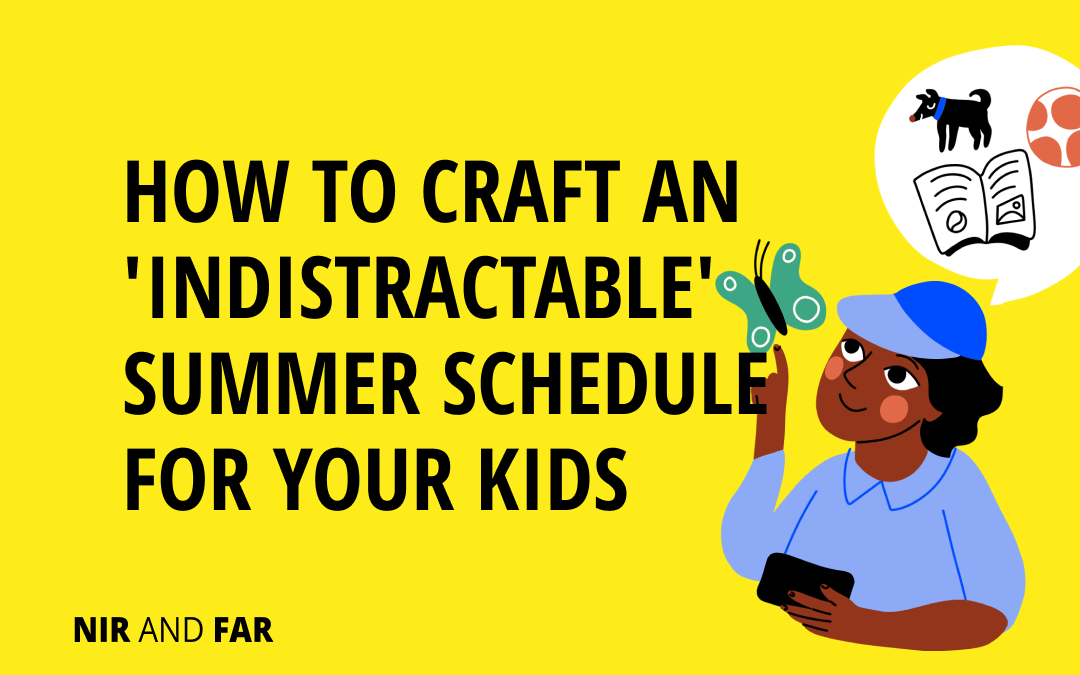Help them make the most of it by becoming “indistractable”
The end of the school year is a magical time.
Kids have made it through a grueling year of groggy early mornings, rigid class schedules, piles of homework, and endless extracurriculars.
Finally, they have two whole months of sunny freedom. It’s a well-deserved break.
But this gift of time can easily be squandered.
If left to their own devices during these months, kids will often turn to, well, their devices.
No parent wants to return home from work to see their offspring on the couch, watching TV or playing video games, or scrolling on smartphones, and wonder, “Have they been doing this all day?”
Yet adults also have to go to work. They’re not available to micromanage how children spend their time. And that’s a good thing—because the better option is to delegate that job to kids.
Summer is an excellent opportunity to teach kids to control their time and attention: the precious skill of becoming indistractable that will transfer to the next school year (and the rest of their lives).
Here’s why adults should help kids design an “indistractable schedule” for the summer:
Summer Is Kids’ Time to Shine
It may seem counterintuitive, but kids have a much better shot at learning to control their time and attention during the summer break than during the school year.
That’s because, during the school year, they’re not really given that option. What they do and when is decided chiefly for them.
But the summer break is their turn to decide.
It also offers kids a chance to soak up the three psychological nutrients they need to become indistractable, which they often lack in schools. These nutrients were identified by Richard Ryan and Edward Deci, renowned human-behavior researchers, in their self-determination theory for psychological well-being:
- Autonomy: volition and freedom of control over their choices
- Competence: mastery, progression, achievement, and growth
- Relatedness: feeling important to others and that others are important to them
Children need these nutrients to grow into capable individuals who can manage their attention and time. If they don’t get sufficient amounts of these nutrients, they seek them in distractions, overindulging in social media and video games.
Unfortunately, most formal schooling in the United States and similar industrialized countries strips kids of the necessary psychological nutrients.
1. Autonomy
Kids don’t have the autonomy to make their own choices at school.
“Teens in the U.S. are subjected to more than 10 times as many restrictions as are mainstream adults, twice as many restrictions as active-duty U.S. Marines, and even twice as many restrictions as incarcerated felons,” according to research from Robert Epstein, author of a 2007 article titled “The Myth of the Teen Brain.”
Barbara Rogoff, a professor at the University of California, Santa Cruz, hypothesizes that “children give up control of their attention when it’s always managed by an adult.”
Kids can become conditioned to lose control of their attention. And since they don’t get autonomy from school, they turn to their devices to find it online, thus becoming highly distractible.
2. Competence
Few kids feel competent in classrooms today.
A primary culprit is the emphasis on standardized testing in many countries. Standardized testing is a one-size-fits-all approach that doesn’t account for differences in development, learning, and intelligence types.
A child who isn’t doing well in school and doesn’t get individualized support will start to believe that achieving competence is impossible, so they stop trying.
Then that child will turn to outlets that make them feel competent—like video games, apps, and other potential distractions.
3. Relatedness
Free play and spontaneous socializing with peers are formative parts of growing up.
However, kids spend so much of their time at school, doing homework, and participating in extracurriculars that they rarely have time for unstructured, unchaperoned socializing. That’s why they spend so much time on their devices seeking communities and interactions in online forums.
It’s not a given that the summer break will feed children these psychological nutrients.
Kids specifically need an indistractable summer. They need to be empowered to decide how to spend their time, do activities that make them feel competent, and build relationships with friends.
If they have that, their interest in devices is likely to wane. But they need help from adults to design an indistractable summer and bring it to fruition.
Help Kids Design an Indistractable Summer
Creating an indistractable summer begins by sitting your kids down to discuss their goals and values and how to make time for them.
I’m sure you imagine your kids groaning in despair at the thought of “scheduling” summer.
But an indistractable summer is not a punishment, a chore, or yet another exercise to control kids. It’s a plan for making sure they have the summer they want. Without a clear plan, many kids are left to make impulsive decisions that often involve digital distractions.
So, follow these steps to build an indistractable summer with your child.
Step 1: Figure out how kids want to spend their time.
Uncover their goals, values, and interests by asking them:
- What qualities or attributes do you admire and want to embody yourself? What activities will help you fulfill those values?
- What do you want to accomplish by the summer’s end, or in general?
- What activities are you interested in doing?
The things your kids come up with might surprise you! They may want to establish a running routine to get in shape for soccer tryouts in the fall. They may want to learn a new skill, like playing an instrument. They may want to volunteer their time to those in need.
Other ideas they have, like playing video games, may come as no surprise at all.
Adults can help kids think about the full range of possible values by introducing them to the three life domains: themselves, work, and relationships.

Step 2: Create a timeboxed schedule to help kids turn those values into time.
Now that kids have identified their values, goals, and interests, ask them how much time they want to dedicate to each related activity.
You may not like your kids’ answers—like how much time they want for playing video games—but it’s important to honor their input and respect their control over their time.
If they try to assign too much time to video games, don’t prohibit it outright. Instead, provide them with research on why that much screen time is unhealthy.
My wife and I don’t enforce a strict bedtime for our daughter. Instead, we made it a point to expose her to research findings showing the importance of ample sleep for adolescents, and she concluded on her own to cut screen time after 9 p.m.
Once your kids know how much time they want to spend on each activity, introduce them to timeboxing, an effective time management technique. Have them schedule their activities into the timeboxed calendar.
Not every minute of every day has to be planned! Kids can kick off their indistractable summer by scheduling just one or two activities a week—and those activities can include free play.
But adults should enforce the idea that once an activity is timeboxed, kids have to stick to their commitment. To help children learn self-regulation, we must teach them to make time for traction by setting aside time for their values, goals, and interests.
Step 3: Enable kids to pursue traction.
While giving kids control of their time is essential, they still need help with logistics.
Some activities, like learning to play guitar through YouTube, are easy for kids to do while home alone.
But other activities happen outside the home, and kids don’t have the ability to do those unless they’re old enough to drive and have access to a car or can take public transportation.
Do you live in a rural place where your kids can’t really leave your property without getting a ride? If you can’t drive them, help them organize a carpool with other families. Or teach your kid to use available public transportation safely.
Kids also may need adult help in researching and booking the activities they want to do, like sleepaway camp, volunteering at a shelter, or joining a sports team.
Summer isn’t just an opportunity for kids to become indistractable; it’s also an opportunity for parents to learn to relinquish control to their kids.By helping your kid to design an indistractable summer, you’re helping them flourish into a more mature individual who’s ready to take on the world.
Remember, the goal of parenting isn’t to raise a child. It’s to bring up a future adult.
Related Articles
- Schedule Maker: a Google Sheet to Plan Your Week
- Habit Tracker Template in Google Sheets
- The Ultimate Core Values List: Your Guide to Personal Growth
- Timeboxing: Why It Works and How to Get Started in 2024
- An Illustrated Guide to the 4 Types of Liars
- Hyperbolic Discounting: Why You Make Terrible Life Choices
- Happiness Hack: This One Ritual Made Me Much Happier

